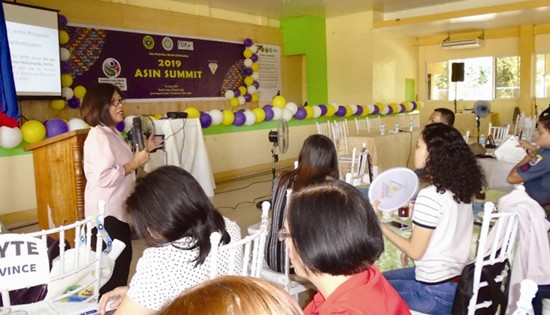|

ASIN
SUMMIT. Felecita R. Borata, DoH-8 Regional Nutrition Program
Manager, tackles the “Iodine Prevention and Control
Program,” during the Asin Summit on July 26, 2019. |
‘Asin’ Summit
conducted in Eastern Visayas region
By
JACK C. GADAINGAN
August 16, 2019
TACLOBAN CITY –
Iodine deficiency remains the single greatest cause of preventable
brain damage and mental retardation. Insufficient intakes of iodine
during pregnancy and early childhood result in impaired mental
development of young children. So that iodization of table salt is
mandated by law as it is one of the best and least expensive methods
of preventing micronutrient malnutrition in the country,
particularly Iodine Deficiency Disorder (IDD).
Felecita R. Borata,
Department of Health Region VIII (DoH-8) Regional Nutrition Program
Manager, revealed this during the “Asin Summit” conducted on July
26, 2019 at the Department of Education (DepEd) Leyte Division
Gymnasium, Palo, Leyte.
The one-day event, a part
of July 2019 Nutrition Month celebration activities, was attended by
municipal health officers (MHOs), provincial, city and municipal
nutrition action officers (P/C/MNAOs), nutritionists/dieticians and
rural sanitary inspectors (RSI) from around Eastern Visayas region.
Also in attendance were a group of salt-traders from Tacloban City,
representatives from government nutrition-partner agencies,
nongovernment nutrition organizations, and the media.
Borata tackled the subject
“Iodine Prevention and Control Program,” where she scrutinized and
explained to the audience the intentions of Republic Act No. 8172
or: “An Act Promoting Salt Iodization Nationwide and for Related
Purposes (Asin Law).” Saying that Salt Iodization strategy has been
implemented in most countries where iodine deficiency is a public
health problem.
The law (RA 8172) intends
to ensure that only iodized salt shall be available in the market
for human and animal consumption, thereby it requires salt
producers/manufacturers, importers, to iodize from 30 to 70 (mg/kg)
or parts-per-million (ppm) the salt they manufacture, produce,
distribute, trade and/or import, as well as the law further requires
salt re-packers to repack and sell only iodized salt.
In Eastern Visayas, the
Regional Bantay Asin Task Force (RBATF) is the body mandated to
ensure the sustainability of the ASIN Law implementation – as well
as to guarantee the iodization of all salt being produced, sold or
traded, and utilized in the region. The body is composed of the DOH,
NNC, DOST, DTI, PNP, DENR, FDA, PPA, PIA and LGUs among others.
The RBATF for the summit,
reported that during a Post Marketing Surveillance on Iodized Salt
from seven establishments conducted on November 6, 2018, result of
the analysis of salt-samples taken from seven salt establishments in
the region failed; and again from another Post Marketing
Surveillance on Iodized Salt conducted on November 7, 2018 on
salt-samples taken from six establishments, only two passed while
the rest failed again.
Considering the volatile
characteristics of iodine, the RBTAF engrained some reminders to the
congregation, particularly the asin traders, distributors and
sellers – that in order to minimize avoidable losses of iodine,
iodized salt should not be exposed to any of the following
conditions during storage, transport and display: 1. direct sunlight
or near source of strong light, 2. high temperature and humidity, 3.
contamination with moisture (e.g. rain, flood, etc.), and 4.
contamination with dust or filth from the environment.